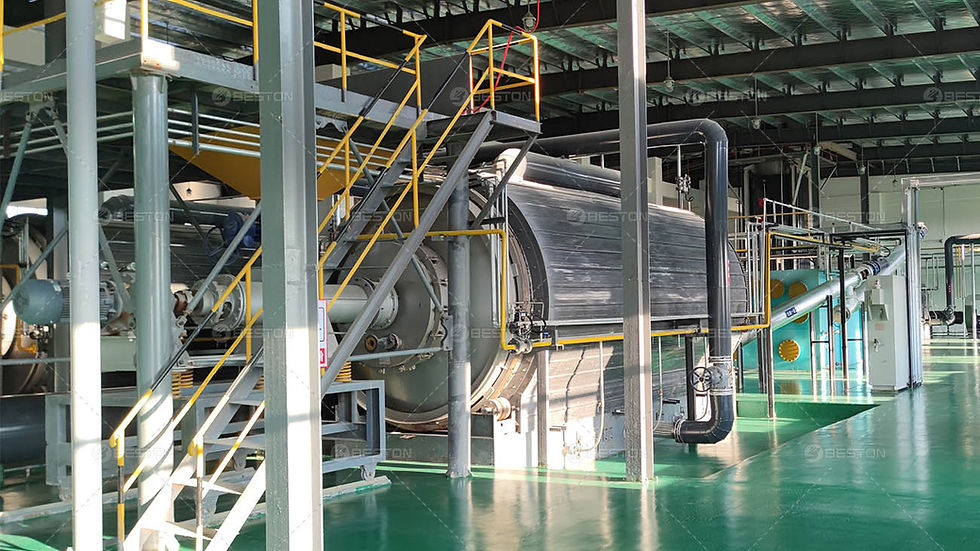Analyzing the Profitability of a Pyrolysis Machine
- wastetoenergy
- May 15, 2024
- 4 min read
In the realm of sustainable waste management and resource recovery, pyrolysis machines stand out as pivotal instruments. These machines, through a process of thermal decomposition, convert organic materials into valuable products such as bio-oil, biochar, and syngas. While their environmental benefits are well-established, assessing the profitability of investing in a pyrolysis machine requires a comprehensive analysis. In this guide, we delve into the key factors and methodologies essential for determining the financial viability of a pyrolysis venture.
Understanding Pyrolysis Machine Cost
The cornerstone of evaluating profitability lies in comprehending the cost dynamics associated with pyrolysis machines. Pyrolysis machine cost encompasses a spectrum of expenses, including initial investment, operational costs, maintenance expenses, and eventual returns.
Initial Investment
The upfront capital outlay for acquiring a pyrolysis machine constitutes a significant portion of the total cost. Factors influencing this cost include the machine's capacity, technological sophistication, build quality, and additional features such as automation and safety mechanisms. Generally, larger-capacity and more advanced machines command higher prices due to their enhanced efficiency and productivity.
Operational Costs
Operating a pyrolysis machine entails various ongoing expenses, primarily fuel or energy consumption, labor costs, raw material procurement, and waste disposal fees. The efficiency of the machine, utilization rate, energy requirements, and market prices of inputs significantly impact operational costs.
Maintenance Expenses
Maintaining optimal functionality and prolonging the lifespan of a pyrolysis machine necessitate periodic maintenance and repairs. Routine servicing, replacement of worn-out components, and unforeseen breakdowns contribute to maintenance expenses. These pyrolysis machine cost vary depending on the machine's design complexity, manufacturer support, and availability of spare parts.
Returns and Revenue Streams
The ultimate goal of investing in a pyrolysis machine is generating returns through the sale of produced outputs. Bio-oil, biochar, and syngas are valuable commodities with diverse applications in energy generation, agriculture, and industrial processes. The market demand, selling prices, distribution channels, and regulatory factors influence the revenue potential of these products.

Analytical Framework for Profitability Assessment
Assessing the profitability of a pyrolysis machine entails a systematic evaluation of various financial metrics and qualitative considerations. Employing a structured analytical framework enables stakeholders to make informed decisions regarding investment feasibility and optimization strategies.
Cost-Benefit Analysis
Conducting a comprehensive cost-benefit analysis facilitates the quantification of investment returns relative to incurred costs. This analysis involves comparing the present value of expected cash inflows (revenue from product sales) with the present value of cash outflows (initial investment and operating expenses over the machine's lifespan).
Return on Investment (ROI)
ROI serves as a fundamental metric for gauging the efficiency and profitability of capital investments, including pyrolysis machines. It is calculated by dividing the net profit generated from the investment by the initial capital outlay and expressing the result as a percentage. A higher ROI indicates greater profitability and value creation.
Payback Period
The payback period represents the duration required for the cumulative net cash inflows to equal the initial investment. Shorter payback periods signify quicker recovery of investment and higher liquidity. Conversely, longer payback periods may indicate higher risk and lower profitability.
Sensitivity Analysis
Given the inherent uncertainties and variability in factors influencing pyrolysis plant profitability, conducting sensitivity analysis is crucial. This involves assessing the impact of changes in key variables (e.g., product prices, input costs, market demand) on financial outcomes. Sensitivity analysis enhances risk management and facilitates informed decision-making under different scenarios.
Lifecycle Assessment
Beyond financial metrics, incorporating lifecycle assessment (LCA) enables holistic evaluation by considering environmental and social impacts. LCA encompasses the environmental footprint, energy efficiency, carbon emissions, and social implications associated with pyrolysis operations. Integrating sustainability criteria alongside financial considerations fosters responsible investment practices and stakeholder engagement.
Practical Considerations and Challenges
While the theoretical framework provides a structured approach to profitability analysis, real-world implementation involves addressing practical considerations and overcoming challenges inherent to pyrolysis ventures.
Regulatory Compliance
Navigating regulatory frameworks governing waste management, environmental protection, and product quality standards is paramount. Compliance with permits, licenses, emissions regulations, and waste disposal protocols ensures legal adherence and mitigates regulatory risks.
Feedstock Availability and Quality
The availability, consistency, and quality of feedstock significantly influence pyrolysis operations and product yields. Accessing sufficient quantities of suitable feedstock at competitive prices is essential for maintaining production continuity and maximizing profitability.
Market Dynamics
The dynamics of markets for bio-based products, renewable energy, and carbon credits exert profound influence on revenue streams and profitability. Understanding market trends, competition, price volatility, and consumer preferences enables effective market positioning and strategic decision-making.
Technological Innovation
Continual technological advancements in pyrolysis processes, equipment design, and product valorization present opportunities for enhancing efficiency and competitiveness. Adopting innovative technologies, improving process integration, and optimizing product portfolios are key drivers of sustained profitability and market differentiation.
Risk Management
Mitigating risks associated with market fluctuations, technological obsolescence, operational disruptions, and regulatory changes is imperative. Implementing robust risk management strategies, diversifying revenue streams, and maintaining financial resilience safeguard against adverse impacts and enhance long-term viability.
Conclusion
Assessing the profitability of a pyrolysis machine necessitates a multifaceted approach encompassing financial analysis, risk assessment, and strategic planning. By understanding the cost dynamics, employing analytical frameworks, and addressing practical considerations, stakeholders can make informed decisions regarding investment feasibility and optimization strategies. Moreover, integrating sustainability principles alongside financial metrics ensures responsible investment practices and long-term viability in the burgeoning field of pyrolysis technology.







Comments